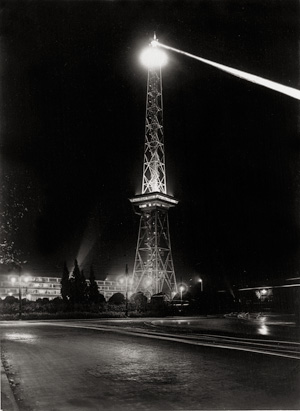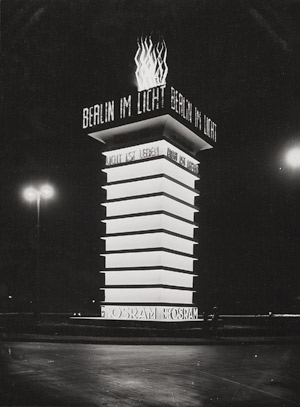Artist Index: Berlin im Licht
Es wurden 2 Lose gefunden. Künstlerbenachrichtigung aktivieren
Los 4097Berlin im Licht
Views of buildings illuminated for 'Berlin im Licht'
Auktion 121
Ergebnis (inkl. Aufgeld) *
35.000€ (US$ 38,889)
Photographer: Martin Höhlig (1882-1948). Views of buildings and locations in Berlin illuminated for the project Berlin im Licht. 1928. 100 vintage, ferrotyped gelatin silver prints on ivory paper. Each circa 22,5 x 16,5 cm and 16,5 x 22,5 cm. Some with number in lower right corner in the negative, inserted in album pages (slight toning in edges), bound in original emerald green cloth presentation album (edges slightly rubbed) with gilt-stamped title Berlin im Licht (25,5 x 35 cm).
From October 13-16, 1928, together with various business organizations and the lighting industry (AEG, Siemens & Halske, Osram), the city of Berlin initiated a visionary propaganda campaign for electric light advertising and illumination of the city under the slogan Berlin im Licht (Berlin Alight). It was a sensation throughout Germany and a spectacular tribute to modern city life. Kurt Weill was even asked to compose a song entitled "Berlin im Licht" for the occasion.
Already in the early 1920s, the designer Walter Dexel had developed the first fluorescent light for advertising purposes. As of 1926 he worked in Frankfurt and designed light advertising to unify facades and create harmony between architecture and advertising. He also used larger designs on facades and on rooftops, as well as illuminated phone booths and columns. There was a clear trend in using light in advertising and architecture.
A group of more than one hundred night views, which are a brilliant testimony to the New Vision in photography of the time, as well as urban and architectural photography, was taken to document the Berlin im Licht event. The collection offered here contains a complete series and in its entirety constitutes a very rare and important part of photographic history. Only a few complete albums remain intact with a series of one hundred photographs each to illustrate the Berlin im Licht project. One is in the collection of the Stadtmuseum Berlin, which was exhibited in 2008 and contains many of the photographs offered here. This group presents a comprehensive overview of all locations involved in the project, among them many modern buildings designed by renowned architects.
The buildings include department stores such as Kaufhaus des Westens ("KaDeWe") and the silk store Michels & Cie., Kurfürstendamm (both designed by Johann Emil Schaudt); the main store of Michels & Cie., Leipziger Straße; the fur store C.A. Herpich & Söhne, Leipziger Straße (Erich Mendelsohn) as well as different branch offices of Hermann Tietz ("Hertie").
A selection of images, which strongly follow the new objectivity aesthetic in photography, depict various retail stores, window shop displays, illuminated advertising columns such as the Berlin im Licht column at Großer Stern, which advertised the event (see p. 96), the Persil column at Potsdamer Platz, as well as brightly lit exterior advertising billboards.
In addition, this collection contains a series of striking images depicting modern cinemas such as: Ufa-Pavillon, Nollendorfplatz (Oskar Kaufmann); Ufa-Palast, Hardenbergstr. and the Titania-Palast, Steglitz (Schoffler, Schlönbach & Jacobi). Hotels are also included, such as the Excelsior, Anhalter Bahnhof (Otto Rehnig) as well as places of public entertainment, such as Potsdamer Platz with Haus Vaterland (Franz Schwechten) and the Columbia Tanz-Cabaret.
The present collection of photographs not only gives a wonderful impression of Berlin at night in the 1920s, but also documents a historical era of Berlin enterprise, especially in the images of department stores and retail stores of Jewish owners, such as the silk store Michels & Cie., the textile shop Hermann Gerson and the luggage, leather and luxury item shop of Albert Rosenhain. These shops were soon closed in the 1930s or "aryanized" and their owners were either deported or forced to emigrate. – All photographs with pressure marks in corners from album slits, some with silver mirroring in edges and corners, some with light handling marks/creases, otherwise most in good to very good condition.
Lit.: Franziska Nentwig (ed.). Berlin im Licht. Berlin 2008, ill. pp. 2 and 224-236.
Fred Richter. Die Weltstadt im Licht. Berliner Nachtfotografien von Martin Höhlig aus den Jahren 1925 bis 1932, many illustrated.
Los 4123Berlin im Licht
Views of buildings illuminated for 'Berlin im Licht'
Auktion 111
Ergebnis (inkl. Aufgeld) *
37.500€ (US$ 41,667)
Photographer unknown. Views of buildings and locations in Berlin illuminated for the project Berlin im Licht. 1928. 100 vintage, ferrotyped gelatin silver prints on ivory paper. Each circa 22,5 x 16,5 cm and 16,5 x 22,5 cm. Some with number in lower right corner in the negative; some with layout marks/numbers in pencil/crayon and/or printed text on the verso. In original green canvas presentation album (26 x 36 cm, edges minimally rubbed) with gilt-stamped title: Berlin im Licht, 50 l with slits for photographs, with original brown case with snap closing fixtures (27 x 37 cm).
From October 13 - 16, 1928, together with various business organizations and the lighting industry (AEG, Siemens & Halske, Osram), the city of Berlin initiated a visionary propaganda campaign for electric light advertising and illumination of the city under the slogan Berlin im Licht (Berlin Alight). It was a sensation throughout Germany and a spectacular tribute to modern city life. Kurt Weill was even asked to compose a song entitled "Berlin im Licht" for the occasion.
Already in the early 1920s the designer Walter Dexel had developed the first fluorescent light for advertising purposes. As of 1926 he worked in Frankfurt and designed light advertising to unify facades and create harmony between architecture and advertising, also using larger designs on facades and on rooftops, as well as illuminated phone booths and columns. There was a clear trend in using light in advertising and architecture.
A group of more than one hundred night views, which are a brilliant testimony to the New Vision in photography of the time, as well as urban and architectural photography, was taken to document the Berlin im Licht event. The collection offered here contains a complete series and in its entirety constitutes a very rare and important part of photographic history. Only a few complete albums remain intact with a series of one hundred photographs each to illustrate the Berlin im Licht project. One is in the collection of the Stadtmuseum Berlin which was exhibited in 2008 and contains many of the photographs offered here. This group offers a comprehensive overview of all locations involved in the project, among them many modern buildings designed by renowned architects.
The buildings include department stores such as Kaufhaus des Westens ("KaDeWe") and the silk store Michels & Cie., Kurfürstendamm (both designed by Johann Emil Schaudt); the main store of Michels & Cie., Leipziger Straße; the fur store C.A. Herpich & Söhne, Leipziger Straße (Erich Mendelsohn) as well as different branch offices of Hermann Tietz ("Hertie").
A selection of images, which strongly follow the line of the new objectivity movement in photography, depict various retail stores, window shop displays, illuminated advertising columns such as the Berlin im Licht column at Großer Stern which advertised the event (see p. 96), the Persil column at Postdamer Platz, as well as brightly lit exterior advertising billboards.
In addition, this collection contains a series of striking images depicting modern cinemas such as: Ufa-Pavilion, Nollendorfplatz (Oskar Kaufmann); Ufa-Palast, Hardenbergstr. and the Titania-Palast, Steglitz (Schoffler, Schlönbach & Jacobi). Hotels are also included such as the Excelsior, Anhalter Bahnhof (Otto Rehnig) as well as places of public entertainment such as Potsdamer Platz with Haus Vaterland (Franz Schwechten) and the Columbia Tanz-Cabaret.
The present collection of photographs not only gives a wonderful impression of Berlin at night in the 1920s, but also documents a historical era of Berlin enterprise, especially in the images of department stores and retail stores of Jewish owners such as the silk store Michels & Cie., the textile shop Hermann Gerson and the luggage, leather and luxury item shop of Albert Rosenhain. These shops were soon closed in the 1930s or "aryanized" and their owners were either deported or forced to emigrate.
Literatur: Franziska Nentwig (ed.). Berlin im Licht. Berlin 2008, ill. pp. 2 and 224-236.
[*]: Regelbesteuert gemäß Auktionsbedingungen. [^]: Ausgleich von Einfuhr-Umsatzsteuer.
* Alle Angaben inkl. 25% Regelaufgeld ohne MwSt. und ohne Gewähr – Irrtum vorbehalten.“
Galerie Bassenge
Erdener Str. 5A
14193 Berlin
Öffnungszeiten:
Montag bis Donnerstag, 10–18 Uhr,
Freitag, 10–16 Uhr
Telefon: +49 30 8938029-0
Fax: +49 30 8918025
E-Mail: info (at) bassenge.com
Impressum
Datenschutzerklärung
© 2024 Galerie Gerda Bassenge
Galerie Bassenge
Erdener Str. 5A
14193 Berlin
Öffnungszeiten:
Montag bis Donnerstag, 10–18 Uhr,
Freitag, 10–16 Uhr
Telefon: +49 30 8938029-0
Fax: +49 30 8918025
E-Mail: info (at) bassenge.com
Impressum
Datenschutzerklärung
© 2022 Galerie Gerda Bassenge


